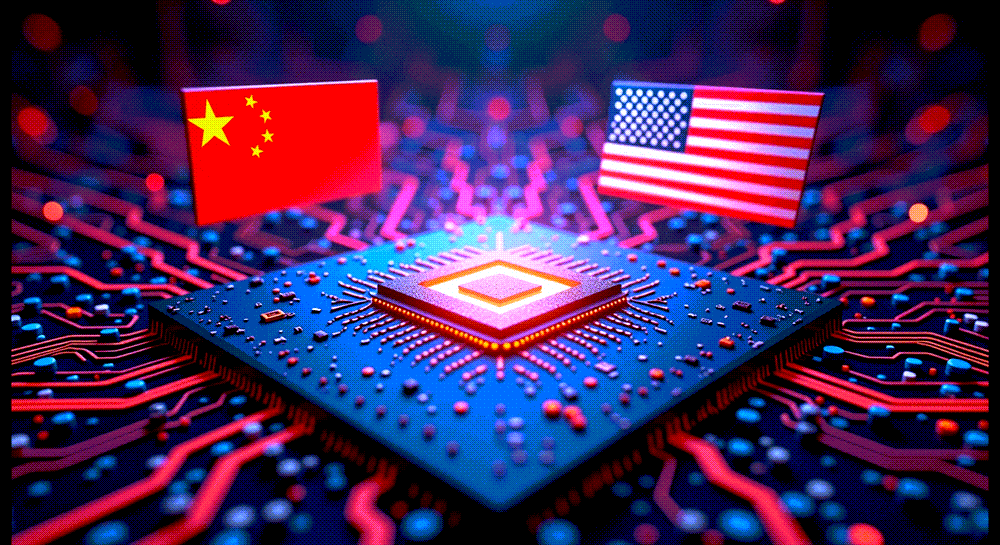The U.S.-China tech rivalry is one of the defining geopolitical conflicts of the 21st century. With both nations competing for technological supremacy, the stakes extend beyond economic competition to issues of national security, global influence, and strategic dominance. From semiconductors to artificial intelligence, the tech industry lies at the heart of this confrontation.
This article explores the geopolitical risks in U.S.-China tech relations, focusing on the key areas of contention, the legal and regulatory challenges, and the broader implications for global technology and policy.
Background: The Roots of U.S.-China Tech Tensions
The U.S. and China have long been strategic competitors, but the tech rivalry intensified with China’s Made in China 2025 initiative. This policy aims to achieve self-sufficiency in high-tech industries and establish China as a global technology leader.
Key Factors Fueling Tensions:
- Economic Competition: China’s rapid advancements in technology challenge U.S. dominance in industries like AI, 5G, and semiconductors.
- National Security Concerns: The U.S. fears that Chinese technology companies could facilitate espionage or gain access to critical infrastructure.
- Global Influence: Both nations seek to shape international tech standards and norms, reflecting broader geopolitical aspirations.
Key Areas of Contention
1. Semiconductors

Semiconductors are the backbone of modern technology, powering everything from smartphones to advanced military systems. The U.S. remains a leader in semiconductor design, but China is investing heavily to reduce its reliance on foreign suppliers.
- Geopolitical Risk: The U.S. has imposed export controls on semiconductor technologies, targeting Chinese firms like Huawei and SMIC, to prevent them from accessing cutting-edge chips.
2. 5G Networks
China’s Huawei has become a global leader in 5G technology, raising concerns about potential backdoors for surveillance.
- Geopolitical Risk: The U.S. has pressured allies to exclude Huawei from their 5G networks, leading to a fragmented global approach to telecom infrastructure.
3. Artificial Intelligence (AI)
AI is a critical frontier for both military and economic applications. China has made significant strides in AI development, often leveraging vast amounts of data.
- Geopolitical Risk: The U.S. has accused China of using AI for surveillance and human rights abuses, such as in the Xinjiang region.

4. Data Privacy and Security
The global flow of data has become a major point of contention, with the U.S. expressing concerns about Chinese companies accessing sensitive information.
- Geopolitical Risk: TikTok, owned by China’s ByteDance, has faced scrutiny over its handling of U.S. user data, leading to calls for bans or divestiture.
5. Supply Chain Vulnerabilities
The COVID-19 pandemic exposed the global economy’s dependence on Chinese manufacturing, including for critical tech components.
- Geopolitical Risk: The U.S. has encouraged “reshoring” and diversification of supply chains to reduce reliance on China.
Legal and Regulatory Challenges
1. Export Controls
The U.S. has expanded export controls to restrict Chinese access to advanced technologies, such as high-performance semiconductors and AI software.
- Impact: These controls disrupt global supply chains and force companies to navigate complex compliance requirements.
2. Foreign Investment Restrictions
Under laws like FIRRMA, the U.S. has heightened scrutiny of Chinese investments in critical industries, often blocking transactions deemed risky.
- Impact: This discourages cross-border collaboration and limits Chinese access to U.S. innovation.
3. Technology Bans
The U.S. has blacklisted Chinese companies, including Huawei, ZTE, and DJI, citing national security concerns.
- Impact: These bans isolate Chinese firms from global markets but also disrupt international trade and innovation.
4. International Trade Disputes
The U.S.-China tech rivalry has spilled into the WTO, where both nations have accused each other of unfair trade practices.
- Impact: Prolonged disputes undermine the global trading system and hinder cooperation on shared challenges.
Broader Implications for Global Technology
1. Balkanization of Technology
The U.S.-China rivalry risks creating a “splinternet,” with separate technological ecosystems and standards emerging in different regions.
- Example: Competing 5G standards and platforms could limit interoperability and raise costs for consumers and businesses.

2. Innovation Slowdown
Export controls and restrictions on collaboration may hinder global innovation, as companies lose access to diverse talent and markets.
- Example: Research partnerships between U.S. and Chinese universities have declined, affecting advancements in AI and other fields.
3. Shifting Alliances
Countries are being forced to align with either the U.S. or China on technology issues, creating new geopolitical alliances.
- Example: The U.S.-led Chip 4 Alliance (U.S., South Korea, Japan, and Taiwan) aims to secure semiconductor supply chains.
4. Human Rights Concerns
China’s use of technology for surveillance and control has raised ethical questions about the role of tech companies in supporting authoritarian regimes.
- Example: The U.S. has imposed sanctions on Chinese firms linked to surveillance in Xinjiang.
Potential Resolutions and Pathways Forward
1. Global Tech Governance
Creating international frameworks for technology regulation could help manage risks while promoting cooperation.
- Example: An international agreement on AI ethics and standards could reduce geopolitical tensions.
2. Bilateral Agreements
The U.S. and China could negotiate sector-specific agreements, such as data-sharing protocols or semiconductor trade terms, to reduce conflict.
3. Strengthening Alliances
The U.S. can work with allies to create unified approaches to tech regulation, ensuring a level playing field while countering Chinese influence.
4. Promoting Transparency
Both nations could enhance transparency in their technology policies to build trust and reduce the risk of misunderstandings.
Conclusion
The U.S.-China tech rivalry is a high-stakes geopolitical conflict with far-reaching implications for global security, economic policy, and technological innovation. While the risks are significant, they also present opportunities for both nations to lead in creating frameworks that promote ethical and responsible technology use.
Navigating this complex relationship requires balancing national security concerns with the need for global cooperation. As technology continues to shape the future, the world will be watching how the U.S. and China manage their tech rivalry—and the consequences for the global order.
